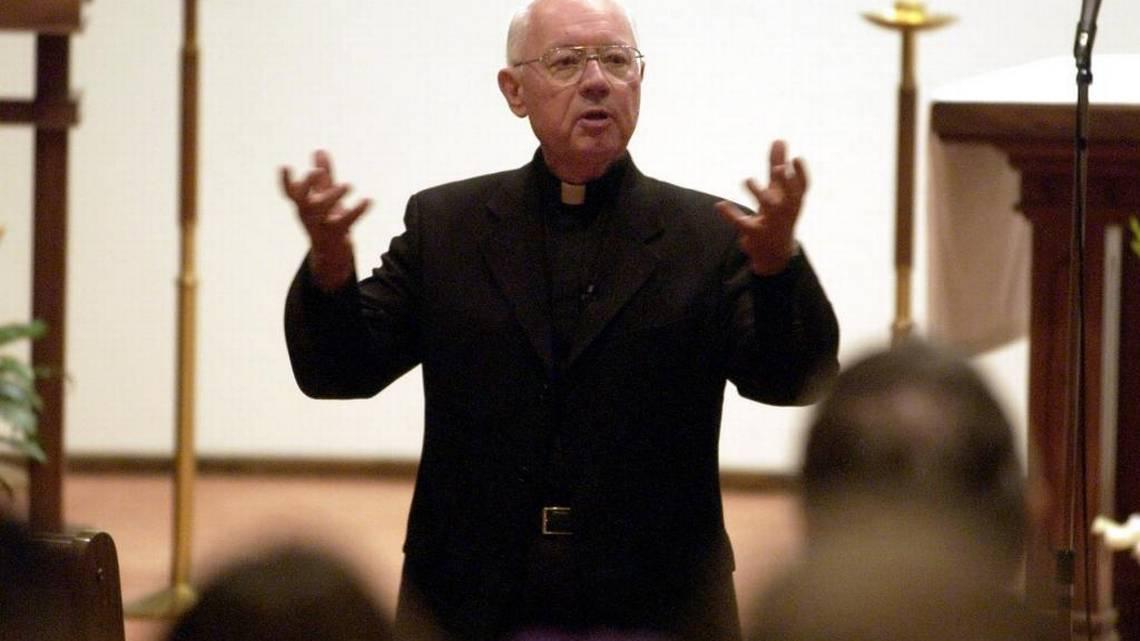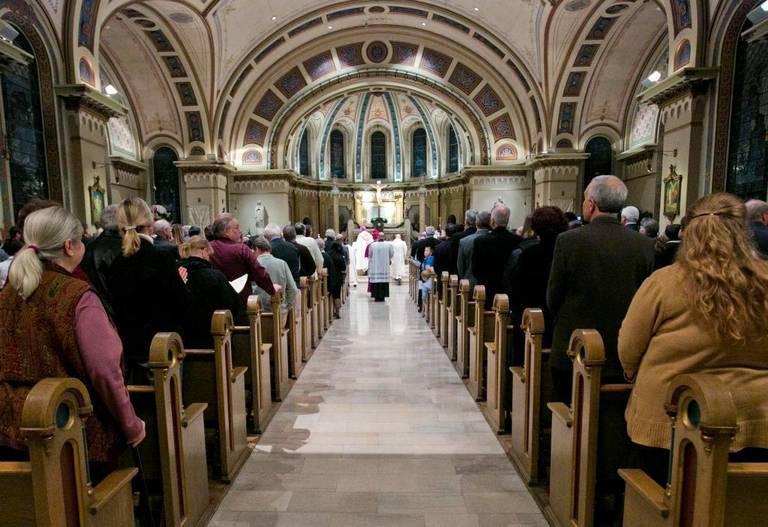|
Catholic sex abuse in Northwest isn’t new. Diocese bankruptcies started here.
By Michael Katz
[with video] It started in Portland. The Catholic Church there — as similar allegations spread worldwide — faced accusation after accusation of child sexual abuse by clergy. Then the Roman Catholic Archdiocese of Portland reached financial strain it could no longer withstand. A total of 54 victims accused Maurice Grammond, a priest who worked at a handful of parishes from 1950 to 1985, of abuse. They sued, costing the church $33.4 million in settlements, according to the Oregonian. The church eventually filed for bankruptcy in 2004, having paid more than $53 million in settlements, according to The Washington Post. A total of 175 victims alleged abuse from the Portland church; their bankruptcy claims were settled for $75 million in 2007, according to Reuters. In the process, it became the first diocese in the country to declare bankruptcy due to sexual abuse cases. Since then, the 15 dioceses nationwide that have declared bankruptcy have paid out a total of about $542.6 million in settlements to victims, though not all of the cases are closed. While one study shows numbers across the United States are eerily consistent in terms of sex abuse allegations from region to region, one prism to quantify and geographically localize the issue is bankruptcies and subsequent settlements. And while the Diocese of Boise has never faced that many allegations — or filed bankruptcy itself — the arrest of one well-known former Boise priest has raised questions about the inner-workings of the church and its protocols for reporting sex abuse. It also shook a neighborhood of young families to its core. The consistency of abuseThe Rev. W. Thomas Faucher was arrested Feb. 2 on 12 charges related to having or distributing child pornography, and two counts of drug possession. He was served an eviction notice Feb. 13 by Saint Mary’s Catholic Church, who owns the home he rents. Neighbors previously expressed concern about his release on bond. His arrest also presented a broader question: How frequent is sex abuse in the Catholic Church, and how frequent is it in Idaho and its neighbors? And what are the consequences of those allegations? Researchers have found the issue of sexual abuse within the Roman Catholic Church is not contained to one specific area in the United States. Regardless of region in the United States, the numbers are consistent. In a study titled “The Nature of Sexual Abuse of Minors by Catholic Priests and Deacons in the United States, 1950-2002,” research by The John Jay College of Criminal Justice found that dioceses across the United States reported 4,392 priests had sexual abuse allegations made against them from 1950 to 2002, making up a total of 4 percent to 4.3 percent of all active priests. More than 95 percent of the 195 diocese surveyed said they had dealt with sex abuse allegations. The range of accused priests per diocese from each region across the country was between 3 percent and 6 percent. Across all regions in the United States, the study found the average number of clerics accused of sexual abuse per diocese was 19. The study found that 75 percent of all incidents allegedly occurred between 1960 and 1984. “The consistency of the findings in dioceses across the United States is remarkable: whether region, number of Catholic communicants or number of parishes is used to array the dioceses, the results show allegations of sexual abuse have been made against 2.5% to 7% of diocesan priests,” the study said. A total of 15 Roman Catholic dioceses in the United States have filed for Chapter 11 bankruptcy protection due to sexual abuse scandals. Of those 15, four are located in the Northwest. Chapter 11 bankruptcy is the reorganization of a business that creates a plan to pay creditors over time while keeping the business or organization open. “Bankruptcies can help to bring order to chaos. … They ensure that hundreds of lawsuits become more manageable and that all victims get paid — not just those who file cases early,” Amy Julia Harris wrote for the Center for Investigative Reporting. “But victim advocates and attorneys say churches that declare insolvency often do it for a less noble purpose. They say it has become a go-to move for dioceses to stop damaging trials and avoid putting church officials on the witness stand.” Why bankruptcy?The Diocese of Boise has never declared bankruptcy. As of 2004, however, churches in Idaho paid about $140,000 in counseling, medical, legal and settlement fees due to 21 “credible accusations” against 12 priests from 1950 to 2002, according to the Catholic Register. The concentration of churches in the Northwest declaring bankruptcy due to settlement payments is the second highest of any other region in the United States. Five of the churches are in the Midwest (Iowa, Wisconsin and three in Minnesota), two are in the Southwest (Arizona, New Mexico), two are on the East Coast (Maryland, Delaware) and one each is in Alaska and California. Including Faucher, a total of eight individuals associated with churches in Idaho have been named in sexual abuse cases, according to BishopAccountability.org, a website whose goal is to “help expose bishops who have abused children or vulnerable adults, or have aided abusers.” Two of the accused individuals in Idaho, Rapelyea “Rap” Howell and Carmelo Melchior Baltazar, were convicted. Howell, a deacon, viewed child pornography on the internet and went to federal prison in 2005. Baltazar, who served as chaplain at Saint Alphonsus Regional Medical Center, was sentenced to seven years in prison and served three after pleading guilty to lewd conduct with a 15-year-old boy. In a letter to congregation members, Archbishop John Nienstadt explained why bankruptcy was necessary for the Archdiocese of Saint Paul and Minneapolis. “Reorganization will allow the finite resources of the Archdiocese to be distributed equitably among all victims/ survivors,” he wrote. “It will also permit the Archdiocese to provide essential services required to continue its mission within this 12-county district.” Donald Palmer, a professor at the University of California, Davis Graduate School of Management, has authored several pieces on child sex abuse within organizations. He believes there may be several factors contributing to why reporting might be more prevalent in one area compared to another. “There might be a higher percentage of victimized children who come forward in the (Northwest),” Palmer said. “It might even be the case that the … churches are more faithful and ‘generous’ at addressing allegations of abuse.” Regions where victims’ allegations are suppressed and fought vigorously will have fewer civil suits and lighter judgments, he said. David Finkelhor, who works at the Crimes Against Children Research Center and helped author the Catholic Priest study, doesn’t believe there is necessarily a correlation between diocese bankruptcies and the severity of sex abuse. He believes the issue is fairly equalized through all regions, a surprising revelation in itself. “I was surprised to see like areas like Boston, which got a lot of attention, weren’t always the highest,” Finklehor said. The NorthwestAlong with the Archdiocese of Portland, three other dioceses in the Northwest have declared bankruptcy. Montana is home to two: the one in Great Falls-Billings and another in Helena. Each declared bankruptcy protection in 2017 and 2014, respectively. The Diocese of Great Falls-Billings filed for bankruptcy in March 2017 after 86 victims claimed they were abused from the 1950s through the 1990s, according to Reuters and the Great Falls Tribune. The number of dioceses in the Northwest declaring bankruptcy doesn’t come as a surprise to Seaborn Larson, a reporter with the Great Falls Tribune in Montana who covered the widespread sexual abuse and subsequent bankruptcy of the Great Falls-Billings Diocese. Larson, a Montana native, did not grow up Catholic. But after months of in-depth reporting, he can’t say the findings of his reporting shocked him. “People knew this kind of thing happened,” Larson said. “When claims of abuse started popping up in Montana, I think people felt violated, but I think it mostly illustrated how widespread these abusers were.” According to the Great Falls Tribune, “predatory priests” within the diocese were placed on Native American reservations around Montana, where they could fly under the radar. Many of the accusers in the case claimed the sexual abuse occurred on the reservations. The bankruptcy settlement is ongoing. “Something that really stuck with me is just how long some of these victims endured abuse,” Larson said. “Some may have been for a few years, others suffered for basically a decade of their youths. That’s just unimaginable.” The Diocese of Helena in Montana was sued by 362 victims. As part of its settlement, the church posted a list of every employee accused of sexual abuse, according to the Helena Independent Record. About $20 million was eventually paid to victims as part of its bankruptcy settlement in 2015. The Roman Catholic Diocese of Spokane declared bankruptcy protection in 2004 after nearly $81 million in liabilities were cited, with $76 million due to sex-abuse claims. At the time, the church had just $11 million in assets, according to the Seattle Times. Much of the case centered around former priest Patrick O’Donnell. Of 176 claims against the Spokane church, 66 of them named O’Donnell, who admitted to molesting boys over a three-decade span, according to The Spokesman Review. O’Donnell was never arrested but was instead “treated” for his pedophilia within the church, The Spokesman Review said. O’Donnell continued abusing boys while he completed therapy, the paper reported. He agreed to pay $5 million to victims to avoid trial. The church ended up paying out $48 million to victims in settlements in the bankruptcy. An additional 21 claims were made against the church in 2009, The Spokesman Review said. The high number of allegations against priests and how the allegations were handled are two major points of contention for Finkelhor, regardless of region. “Why were the allegations and cases so badly handled and so few people held accountable? And that’s the thing that is still a flash point,” he said. “There’s more of a concern that the church has done a better job of preventing new cases than holding people accountable.” Contact: mkatz@idahostatesman.com
|
.
Any original material on these pages is copyright © BishopAccountability.org 2004. Reproduce freely with attribution.

